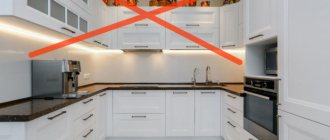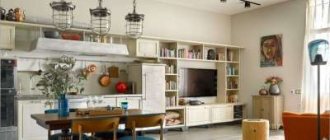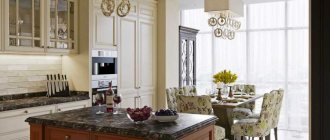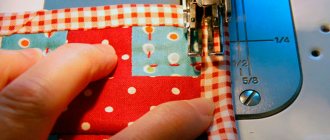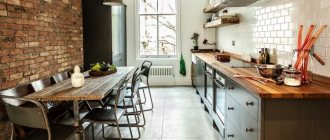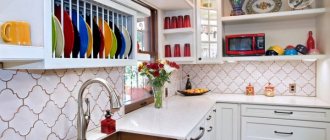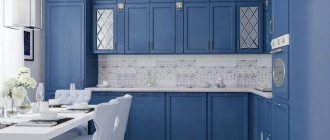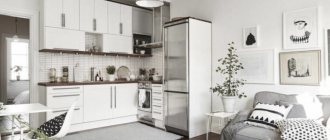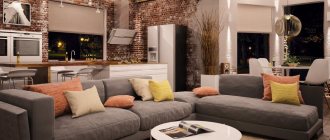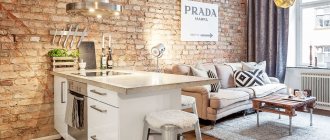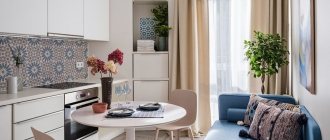Patchwork or patchwork is primarily associated with grandma's colorful blanket made from the remains of different fabrics. Fun and cozy patchwork items found in old chests eventually migrated into the category of decorative accessories. Modern designers have gone even further. They decided that the patchwork technique was suitable for more than just textiles. For example, patchwork wall or floor tiles for the kitchen can simultaneously serve as a reliable covering and decorate the room. Curtains, potholders, napkins, furniture upholstery - all this can also be decorated using the patchwork technique. There is only one limitation - there should not be too much diversity.
And what is it?
Strictly speaking, it would be an exaggeration to call patchwork an independent style. This is a special weaving system using different flaps in one product.
But now the concept has expanded: it is used to decorate ceilings, walls and kitchen aprons.
Of course, the range of materials has also become wider - now the term refers not only to textiles, but also to tiles, wallpaper and even painting.
The popularity of patchwork and the closely related quilt (a special method of sewing quilted two-layer fabric) can be explained very simply: they can add coziness to any kitchen.
Let's figure out what its features are and how best to use this unusual technique in modern kitchen interiors.
Patchwork tablecloth
We cover the table with such a tablecloth and serve it with glee!
This master class will help us easily sew a patchwork tablecloth: cutting and sewing it is not difficult if we use one of the proposed patterns for arranging the patches.
Note! All patchwork patterns will add attractiveness and neatness to our product, and help avoid annoying wrinkles and other flaws due to the mismatch of the shape of one patch to another. By the way, we can draw such a diagram ourselves.
Tools, materials
- 10 squares of multi-colored shreds 25x25 cm;
- threads according to the color of the fabric;
- template 21x21 cm;
- chalk;
- iron;
- pins;
- sewing machine.
Step by step guide
Scheme for cutting flaps
- We cut out 9 squares of 21x21 cm of prepared flaps under the plexiglass template.
- We cut them according to the EF and GH lines of the diagram.
- From the resulting parts we form squares.
- We fasten them with pins, sew and iron all the seams.
- We cut these squares along IJ lines.
- From the formed flaps we combine the squares and sew them together.
- We make a tablecloth from sewn squares.
- Sew the border to the fabric (its width is approximately 8 cm).
- We bend the edge of the edging inward by 1 cm and stitch it.
- We cut out the lining and sew it on.
Let's try to combine
To be honest, the idea of decorating the entire room in this style does not seem very successful to us: the result will be too colorful and will tire the eyes. But making it an accent is a great solution.
It would be logical to assume that such flashy decor is not appropriate everywhere - for example, it is difficult to imagine it in a classic kitchen or, conversely, in a high-tech room.
But for Provence, country, Scandinavian or Mediterranean design, this is what you need.
The patchwork style looks no less impressive in the interiors of kitchens made in the shabby chic or boho traditions - wherever bright colors and ethnic patterns are welcome.
But in general, you can always experiment - probably a good specialist will help you develop a design project with a successful combination of this style and loft. The main thing is to imagine how such a combination will look in real life, so that later you don’t have to hastily redo the renovation.
To do this, you need to understand all the nuances well. Let's get started?
How to choose color and print
As a rule, white, shades of beige or blue are chosen for the background. You can use other pastel colors, provided that the patterns on the tiles and the color of the finish are at the same “temperature”. That is, warm colors are combined with warm colors, cold colors are combined with cold ones.
Important! “Warm” is a color or shade in which yellow tones predominate; cold tones have more blue tones. You should not mix colors of different “temperatures” in the same interior. This will create unpleasant chaos and a feeling of sloppiness.
When it comes to tiles for floors and walls, it is wiser to choose a ready-made set. The safest option is a monochrome palette on a plain background. For example, a white kitchen with a patchwork apron in the same color scheme.
Always a win-win option - a combination of basic colors:
- black;
- white;
- brown;
- blue.
These are natural shades. They go well together and act as a neutral background for other colors.
The pattern on the tiles should not be too large and clumsy. Small, elegant, “transparent” patterns on patchwork tiles will add lightness and charm to the kitchen interior. Designers advise not to limit yourself to three or four ornaments, but to use as many designs of different shapes and styles as possible. This advice is justified if the selection is carried out by a professional or a ready-made set of tiles assembled at the factory by specialists is used.
Important! Combining too different designs on your own, even those united by the same background color, is risky - the result can be unpredictable.
Keep a sense of proportion
Patchwork is characterized by bright, rich colors and catchy patterns. You understand that if you make a similar design on all the walls or ceiling, then very soon the kitchen will tire you?
It attracts attention, so we recommend using it to accent some piece of furniture or decor. Don’t make it predominant—one or two elements are enough.
- In a small kitchen, use it to decorate a backsplash with tiles or create an original wicker curtain from patches;
- On a large one - for a panel or mosaic fresco. Measure the dimensions so as not to overdo it.
You can deviate from this rule only for a kitchen made in the style of shabby chic or boho chic - where such exaggeration sometimes becomes a highlight.
Styling tips
When decorating a kitchen apron, it is better if the main part of the picture or panel is in the center of the wall. The mosaic is placed on a well-leveled surface. You don’t need any special skills to install it, but you will need to grout a large number of seams.
Before laying a combined floor, you need to familiarize yourself with the methods of decorating joints. One of the most aesthetically pleasing options is sealing the seams with a thin strip of cork, which can be matched to the color of the wood covering. You can also use metal strips up to 2 cm wide.
The same type of tiles are laid on the walls and floor according to the chosen pattern. When chaotically combining plain and colored tiles, it is important to maintain the proportions: 65-70% plain by 35-40% with a pattern.
Lots of textiles
As we said earlier, first of all it is working with fabric. Yes, the motifs have transferred to other materials. But if you want a truly authentic style, you'll have to focus on textile accessories.
Their choice is unusually wide: starting from rugs covering the entire floor (we think this idea will be especially appreciated by those who live in a private house without heated floors) and ending with such little things as covers for stands for devices and potholders made by themselves.
The undoubted advantage of this type of decor is the ability to make it yourself. The execution method has its own characteristics, but it is not too difficult to learn - the main thing is a little perseverance.
Furniture
Furniture decorated in this way also deserves a few words. You can rarely find it in kitchens, but if you have a desire to complement the interior with such unusual pieces of furniture, it is quite possible. If you don’t want to completely reupholster your existing chairs or sofa, you can use covers, which can also be washed if necessary, avoiding the difficult procedure of cleaning furniture upholstery.
Internationality
Initially we said that the style originated in England. However, now it has become widespread - such a technique is often found in Japanese or French styles or a completely unexpected Art Deco patchwork.
The latter is distinguished by a more sophisticated range using pastel and golden shades.
Therefore, no matter what repair you decide to do, you will most likely find suitable patchwork accessories.
Choose wisely
In addition to national characteristics, the method of execution also differs. No matter what you decide to decorate in this style - curtains or a patchwork tile backsplash for the kitchen, understanding the types will help you make a choice.
For example, crazy is suitable for shabby chic - lack of symmetry, a large number of frills and decorative elements. But for Provence, the watercolor technique is suitable - soft tones, as if flowing into each other.
An unusual and catchy ornament is “honeycomb”. It will not suit every design, but if you can choose a worthy background for such wallpaper or a textile element, then it will become a real decoration of the room..
This technique in the interior of a home kitchen can be both a winning solution and a tool that will blur the entire impression - think three times before making the final choice.
Types of patchwork
Let's look at the features of patchwork in different directions that are suitable for the kitchen.
English patchwork
Affordable and most popular type of patchwork.
- It requires flaps of the same size and shape, and their picture has a specific meaning. And everything is very thought out, neat, perfect.
- We will add fringe, canvas, ribbons, embroidery to a product sewn from scraps and make the decor more sophisticated and interesting, as shown in the photo.
Crazy patchwork
Slightly chaotic-looking patchwork.
- Crazy is not a justified name for such charming and original products from a seemingly incompatible set of all kinds of scraps, different in color and shape.
- Only the imagination of the craftswoman determines their design - this is the dignity of the look and its exclusivity.
Japanese patchwork
Imitation of oriental ornaments.
- It is harmonious, conducive to relaxation and is liked by wise and balanced people.
- Creating Japanese patchwork is like magic and does not require garish contrast in a patchwork color scheme.
- The craftsmen's instructions say: products in oriental embroidery should be decorated with fringes and tassels.
Having made the decor in the type of patchwork we like, we will reflect our nature as if in a mirror and, of course, will inimitably decorate the kitchen.
Weaving from wallpaper?
In fact, you don't need to do this. But you will have to think about which pieces to choose to create a patchwork mosaic.
As we have already said, one of the main features of the technique is rich and bright colors. For those who decide to buy a ready-made canvas, you just need to choose the one you like.
If you plan to choose a wallpaper design yourself in order to make a truly unique coating, you will need to work hard. However, modern technologies will solve the problem for you - there are programs that will find beautiful color combinations.
As for general recommendations, they are extremely simple:
- Select only one wall with patchwork, otherwise the kitchen will be too colorful.
- Choose wallpaper of different colors and textures, but of the same thickness.
- The remaining walls and decor should be as monochromatic as possible to highlight the beauty of the complex coating.
What about the tiles?
Floor or wall tiles laid in a patchwork style are almost as common as textile accessories.
The same rules apply here as for wallpaper - everything should be bright, but harmonious. Do not try to mix all the colors at once - such a move will definitely be overkill. But choosing tiles of different shapes is a good solution.
If you are not sure that you can do the work yourself efficiently, then it is better to turn to professionals - accuracy is very important.
We recommend that you first study a number of photos - this will help you decide on the intended pattern.
In the bathroom (photo)
Framing the mirror with tiles gives some semblance of a frame. It is not recommended to use a mirror built into the door of a hanging cabinet for this idea. As well as a mirror with a baguette or other frame.
Designer Ponkratova Alena
Project: UDesign
If the bathroom is combined and there is a partition separating the toilet, bright tiles on it will decorate all spaces. A ceiling-length panel on the wall in the shower area will add atmosphere to the entire bathroom. The same “picture” on the floor in the central part will complement the composition and create the impression of carpeting. An original solution is the point placement of individual tiles.
Design studio of Anton Sukharev “Sukharevdesign”
The excessive activity of patchwork tiles in the bathroom is diluted with another monochromatic series. It will become the background for creating contrasting decor.
Designer Maxim Noda Sochi
Possible combinations
As you already understand, giving patchwork a dominant place in a kitchen renovation is a mistake. But in this case, you need to take a responsible approach to the choice of materials that shade it.
Turning to the history of the appearance of technology, it becomes clear that this is a rural invention. So it would be logical to use natural materials (or their high-quality imitation) - stone, wood, ceramics.
Try to avoid overly modern surfaces - plastic and glass can look good together with patchwork, but then there is no need to talk about respecting its stylistic features.
Make sure that the intended design project in the interior will look as great as in the photo - some people underestimate the brightness of such decorative elements against the backdrop of more restrained coatings.
Potholders
Patchwork potholders are practical and decorative.
Their gift sample is a pleasant surprise for loved ones. The main advantage is low thermal conductivity (Also find out how to sew oven mitts for the kitchen with your own hands).
Square potholder
To make it we need:
- cotton fabric;
- threads;
- batting;
- cotton edging.
Procedure
- Let's make a cardboard square - a template and cut it out.
- Apply it to the fabric and outline it with chalk, taking into account the seam allowances.
- Let's cut out 2 of these squares.
- Connect the squares with pins.
- We sweep them away by hand.
- We will make a loop from the braid and insert it between the squares.
- We sew the tack, leaving 5-6 cm unsewn, so that we can then turn it inside out and push the batting inside.
- We sew the unstitched area by hand.
Note! The heart-shaped patchwork tack is done in the same way, but it is better to edge it all with braid.
Patchwork mitten
- This more complex type of product is made in the same way as a square, but in two copies, which we then sew together like a mitten.
- The template will save us from defects, and the edging will smooth out small inaccuracies.
Don't forget about the little things
Even if you decorate your kitchen with a huge wicker panel covering an entire wall, the true manifestation of the patchwork style is reflected in the small details.
Think about what items you would like to place additional emphasis on: they should resonate with the main element, as if emphasizing and shading it.
Don’t be afraid to use handmade ones - it will add uniqueness to the room, which is so valued by lovers of this technology.
What can we say in conclusion? Patchwork is a unique stylistic addition that will help create an atmosphere of warmth and comfort in the kitchen. But you need to be very careful with it - no overdoing it, otherwise the effect will be exactly the opposite.
Personally, we would recommend it to those who like bright things “with history.” But for lovers of more classic interiors, we advise you to look at the special section of our website.
Apron
The backsplash is the first and foremost place to use Patchwork to add personality to your kitchen. It plays not so much an aesthetic, but primarily a practical role in the kitchen, keeping the work area clean.
Patch tiles essentially give you creative freedom and add color and pattern to a room in abundance, but you don't have to be limited to just the traditional design approach of using the standard 5-6 patterns.
Any style will do, from eclectic to sophisticated, from monochrome to a stunning Mediterranean that has irrepressible vitality. Each composition should be full of uniqueness, expressiveness and intrigue.
Rustic style
